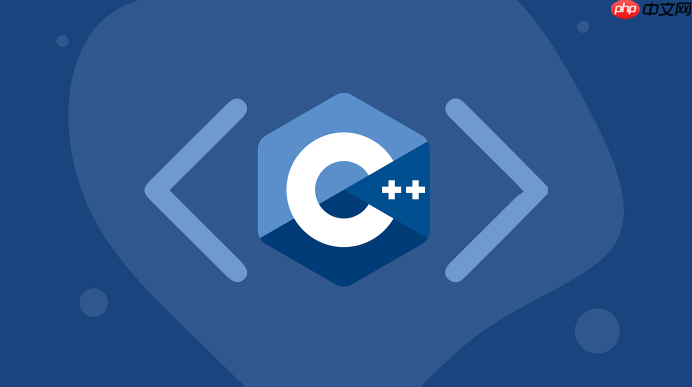auto关键字用于自动类型推导,简化代码并提升可读性,适用于迭代器、模板、Lambda表达式等场景,但需注意必须初始化、无法用于函数参数和非静态成员变量,且不保留引用和const属性,需结合decltype和显式转换避免推导错误。

C++ 中的 auto 关键字主要用于类型推导,让编译器自动确定变量的类型,从而简化代码并提高代码的可读性。它特别适用于类型名冗长或难以书写的情况。
C++ auto 类型推导关键字详解
auto 关键字允许编译器根据初始化表达式自动推断变量的类型。这可以减少代码冗余,并使代码更易于维护。但使用时需要注意一些细节,以避免潜在的类型推导错误。
什么时候应该使用 auto 关键字?
立即学习“C++免费学习笔记(深入)”;
auto 在以下场景中特别有用:
类型名冗长或难以书写: 例如,使用 STL 容器的迭代器时,类型名可能很长,使用 auto 可以简化代码。
#include <iostream>
#include <vector>
int main() {
std::vector<int> numbers = {1, 2, 3, 4, 5};
// 不使用 auto
std::vector<int>::iterator it = numbers.begin();
// 使用 auto
auto auto_it = numbers.begin();
std::cout << *it << std::endl;
std::cout << *auto_it << std::endl;
return 0;
}类型依赖于模板参数: 在泛型编程中,变量的类型可能依赖于模板参数,使用 auto 可以避免手动指定类型。
template <typename T, typename U>
auto add(T a, U b) -> decltype(a + b) {
return a + b;
}
int main() {
auto sum = add(1, 2.5); // sum 的类型被推导为 double
std::cout << sum << std::endl;
return 0;
}Lambda 表达式: Lambda 表达式的类型是匿名的,只能使用 auto 来声明变量。
#include <iostream>
#include <functional>
int main() {
auto lambda = [](int x, int y) { return x + y; };
std::cout << lambda(3, 4) << std::endl;
return 0;
}避免手动指定类型: 有时,手动指定类型可能会出错,使用 auto 可以避免这种错误。
#include <iostream>
int main() {
int x = 10;
double y = 3.14;
// 如果手动指定类型,可能会出错
// double result = x * y; // 错误:int * double 隐式转换为 int
// 使用 auto
auto result = x * y; // result 的类型被推导为 double
std::cout << result << std::endl;
return 0;
}auto 推导的类型与 decltype 的区别是什么?
auto 和 decltype 都用于类型推导,但它们的推导规则不同。
auto:根据初始化表达式推导变量的类型,忽略引用和 const/volatile 限定符,除非显式声明为引用或指针。decltype:返回表达式的精确类型,包括引用和 const/volatile 限定符。#include <iostream>
int main() {
int x = 10;
int& ref = x;
auto a = ref; // a 的类型是 int (忽略引用)
decltype(ref) b = x; // b 的类型是 int& (保留引用)
const int y = 20;
auto c = y; // c 的类型是 int (忽略 const)
decltype(y) d = 30; // d 的类型是 const int (保留 const)
a = 15; // 修改 a 不会影响 x
b = 25; // 修改 b 会影响 x
// d = 35; // 错误:d 是 const int,不能修改
std::cout << "x: " << x << std::endl; // 输出 x: 25
std::cout << "a: " << a << std::endl; // 输出 a: 15
std::cout << "b: " << b << std::endl; // 输出 b: 25
std::cout << "c: " << c << std::endl; // 输出 c: 20
std::cout << "d: " << d << std::endl; // 输出 d: 30
return 0;
}auto 的使用限制有哪些?
auto 必须初始化:auto 声明的变量必须立即初始化,以便编译器推导类型。
// 错误:auto 变量必须初始化 // auto x; auto x = 10; // 正确
auto 不能用于函数参数:在 C++11 中,auto 不能用于函数参数的类型推导(C++20 引入了 Concepts 可以实现类似的功能)。
// 错误:auto 不能用于函数参数
// void func(auto x) {}
template <typename T>
void func(T x) {} // 正确auto 不能用于非静态成员变量:在 C++11 中,auto 不能用于非静态成员变量的类型推导(C++11 之后,可以使用默认成员初始化来解决)。
class MyClass {
public:
// 错误:auto 不能用于非静态成员变量
// auto x;
MyClass() : x(10) {} // 正确
private:
int x;
};auto 不能推导数组类型:auto 会将数组推导为指针类型。
#include <iostream>
int main() {
int arr[] = {1, 2, 3, 4, 5};
auto a = arr; // a 的类型是 int*,而不是 int[]
std::cout << sizeof(a) << std::endl; // 输出指针的大小,例如 8 字节
return 0;
}auto 不能推导位域类型。
struct S {
int b:3;
};
int main() {
S s;
s.b = 2;
// auto x = s.b; // 错误,不能推导位域类型
int x = s.b; // 正确
return 0;
}如何避免 auto 类型推导错误?
显式指定类型: 在类型推导不明确或可能导致错误的情况下,显式指定类型。
auto x = 10; // x 的类型是 int auto y = 3.14; // y 的类型是 double auto z = 10L; // z 的类型是 long
使用 static_cast 进行类型转换: 在需要进行类型转换时,使用 static_cast 显式转换类型。
int x = 10; double y = 3.14; auto result = static_cast<double>(x) * y; // result 的类型是 double
注意引用和 const/volatile 限定符: 如果需要保留引用或 const/volatile 限定符,可以使用 auto&、auto const 或 auto const&。
int x = 10; auto& ref = x; // ref 的类型是 int& const auto& const_ref = x; // const_ref 的类型是 const int&
了解 auto 的推导规则: 熟悉 auto 的推导规则,避免在不适用的场景中使用 auto。
总的来说,auto 关键字是一个强大的工具,可以简化 C++ 代码并提高代码的可读性。但需要注意其使用限制,并避免潜在的类型推导错误。通过合理使用 auto,可以编写更清晰、更易于维护的代码。
以上就是c++++如何使用auto关键字_c++ auto类型推导关键字详解的详细内容,更多请关注php中文网其它相关文章!

c++怎么学习?c++怎么入门?c++在哪学?c++怎么学才快?不用担心,这里为大家提供了c++速学教程(入门到精通),有需要的小伙伴保存下载就能学习啦!

Copyright 2014-2025 https://www.php.cn/ All Rights Reserved | php.cn | 湘ICP备2023035733号